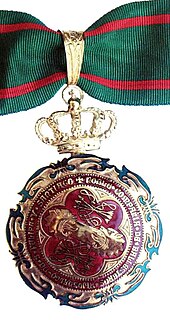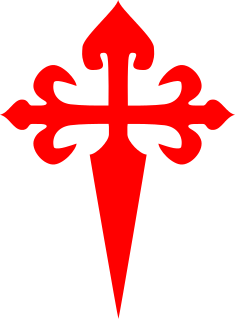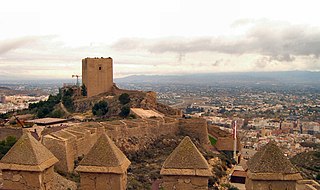
Murcia is a city in south-eastern Spain, the capital and most populous city of the Autonomous Community of the Region of Murcia, and the seventh largest city in the country, with a population of 447,182 inhabitants in 2018. The population of the metropolitan area was 689,591 in 2010. It is located on the Segura River, in the Southeast of the Iberian Peninsula, noted by a climate with hot summers, mild winters, and relatively low precipitation.

Almogavars is the name of a class of soldier from many Christian Iberian kingdoms in the later phases of the Reconquista, during the 13th and 14th centuries. Almogavars were lightly clad, quick-moving frontiersmen and foot-soldiers. They hailed from the Kingdom of Aragon, the Principality of Catalonia, the Kingdom of Valencia, the Crown of Castile and the Kingdom of Portugal. At first these troops were formed by farmers and shepherds originating from the countryside, woods and frontier mountain areas. Later, they were employed as mercenaries in Italy, Latin Greece and the Levant.

Gonzalo Jiménez de Quesada y Rivera, also spelled as De Quezada and Ximénez, (Spanish: [gonˈθalo xiˈmeneθ ðe keˈsaða]; 1496 – other sources state 1506 or 1509 – Suesca, 16 February 1579 was a Spanish explorer and conquistador in northern South America, territories currently known as Colombia. He explored the northern part of South America. As a well-educated lawyer he was one of the intellectuals of the Spanish conquest. He was an effective organizer and leader, designed the first legislation for the government of the area, and was its historian. After 1569 he undertook explorations toward the east, searching for the elusive El Dorado, but returned to New Granada in 1573. He has been suggested as a possible model for Cervantes' Don Quixote.

Molina de Segura is a municipality of Spain in the autonomous community and province of Murcia. It is located 10 km from the provincial capital, Murcia.

Fuente Álamo de Murcia is a town and municipality in the Region of Murcia, southern Spain. It is situated 22 km northwest of Cartagena and 35 km south west of Murcia. The town lies in the basin of the Mar Menor surrounded by the mountains of Algarrobo, Los Gómez, Los Victorias and the Carrascoy.
Luis Yáñez Fajardo y La Cueva, 2nd Marquis of los Vélez, Grandee of Spain,, was a Spanish military and nobleman.

Among several forms historically adopted by the Spanish nobiliary colleges - such as corporations, confraternities, companies, and chivalric orders - are the military brotherhoods, such as the Noble Company of Knights Crossbowmen of Saint Philip and Saint James. The Noble Company was founded circa 1350 in the town of Alfaro. Membership in the Noble Company has always been considered a "positive act of nobility," creating or confirming the Knights Crossbowmen as hidalgos with "nobility of blood and arms." The crossbow as a military and hunting weapon was already known by the Romans. After a relative dark period it came to have a preeminent place in the 11th century in European armories and for hunting wild game.

The Region of Murcia, is an autonomous community of Spain located in the southeast of the state, between Andalusia and Valencian Community, on the Mediterranean coast.

Muhammed IX (1396–1454) was the fifteenth Nasrid ruler of the Emirate of Granada in Al-Andalus on the Iberian Peninsula. He was likely the father of Aixa.

Holy Week in Spain is the annual tribute of the Passion of Jesus Christ celebrated by Catholic religious brotherhoods and fraternities that perform penance processions on the streets of almost every Spanish city and town during the last week of Lent, the week immediately before Easter.

Gonzalo Ruiz Girón was a Spanish nobleman from Palencia. He was Grand Master of the Order of Santiago, and Adelantado of the Kingdom of Murcia. Ruiz was killed at the Battle of Moclín. He was a member of the House of Girón.
The 2012–13 Copa Federación de España is the 20th staging of the Copa Federación de España, a knockout competition for Spanish football clubs in Segunda División B and Tercera División.

The Order of Saint Mary of Spain, also known as the Order of the Star, was a Spanish military order concentrating in naval activity created by Alfonso X of Castile, King of León and Castile in 1270.

The Battle of Los Alporchones was a battle of the Spanish Reconquista that took place on 17 March 1452. The battle was fought between the troops of the Emirate of Granada and the combined forces of the Kingdom of Castile and its client kingdom, the Kingdom of Murcia. The Moorish army was commanded by Malik ibn al-Abbas and the Castilian troops were commanded by Alonso Fajardo el Bravo, the head of the House of Fajardo and the Alcalde of Lorca Castle. The battle was fought in the area around the city of Lorca and resulted in a victory for the Kingdom of Castile.

The border of Granada was a border region that existed between the Nasrid kingdom of Granada and the kingdoms of Murcia, Jaén, Córdoba and Seville following the integration of those former Muslim territories within the Crown of Castile in the mid-13th century. The delineation of this border region underwent several changes subsequently, but on the death of Alfonso XI in 1350, the Granadine border was fixed geographically, in general terms, until the beginning of the Granada War in the late 15th century. This territory was also referred to as La Banda Morisca.

The 1991 Murcian regional election was held on Sunday, 26 May 1991, to elect the 3rd Regional Assembly of the Autonomous Community of the Region of Murcia. All 45 seats in the Regional Assembly were up for election. The election was held simultaneously with regional elections in twelve other autonomous communities and local elections all throughout Spain.

The 2007 Murcian regional election was held on Sunday, 27 May 2007, to elect the 7th Regional Assembly of the Autonomous Community of the Region of Murcia. All 45 seats in the Regional Assembly were up for election. The election was held simultaneously with regional elections in twelve other autonomous communities and local elections all throughout Spain.
The 2017 Segunda División B play-offs are the final playoffs for promotion from 2016–17 Segunda División B to the 2017–18 Segunda División. The four first placed teams in each one of the four qualify for the promotion playoffs and the four last placed teams in Segunda División are relegated to Segunda División B. It also decides the teams which placed 16th to be relegated to the 2017–18 Tercera División.



















